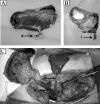A preclinical canine model for composite tissue transplantation
- PMID: 20108180
- PMCID: PMC2975549
- DOI: 10.1055/s-0030-1247717
A preclinical canine model for composite tissue transplantation
Abstract
The feasibility of composite tissue allografts (CTAs) has been demonstrated by the successful transplantation of the hand, abdomen, and face. However, the survival of these transplants depends on immunosuppression. Our laboratory is interested in achieving tolerance to decrease the risks associated with the use of chronic immunosuppression. The purpose of this experiment was to develop a large-animal model for CTA. Four canine flaps were autotransplanted to examine the use of a myocutaneous rectus flap based on the deep inferior epigastric vessels. Five CTA transplants were performed between dog leukocyte antigen (DLA)-identical littermates without posttransplant immunosuppression. The allografts were followed clinically and underwent routine biopsies. The anatomic dissections and autotransplants were all successful and revealed that the flap could be divided into two separate components. Skin was perfused by the superficial epigastric artery. Rectus muscle was perfused by the deep inferior epigastric system. This allowed the allografts to be transplanted as muscle or skin or with both components based on the external iliac artery and veins. The DLA-identical littermates rejected the allografts in 15 to 30 days. This study demonstrated the versatility of the myocutaneous rectus flap for use in canines as CTA models.
Copyright Thieme Medical Publishers.
Figures





Similar articles
-
A chimeric flap model in dogs.J Reconstr Microsurg. 2011 Mar;27(3):163-8. doi: 10.1055/s-0030-1270530. Epub 2010 Dec 21. J Reconstr Microsurg. 2011. PMID: 21181623
-
Internal mammary perforators as recipient vessels for deep inferior epigastric perforator and muscle-sparing free transverse rectus abdominis musculocutaneous flap breast reconstruction in an Asian population.Ann Plast Surg. 2014 Aug;73(2):170-3. doi: 10.1097/SAP.0b013e318270704b. Ann Plast Surg. 2014. PMID: 23528630 Clinical Trial.
-
[Preliminary dissection of the blood supply on myocutaneous flap of rectus abdominis on hypogastric zone].Zhongguo Xiu Fu Chong Jian Wai Ke Za Zhi. 2006 Sep;20(9):877-80. Zhongguo Xiu Fu Chong Jian Wai Ke Za Zhi. 2006. PMID: 17036969 Chinese.
-
Double deep inferior epigastric arteries encountered during vertical rectus abdominis flap harvest: a case report and literature review.Ear Nose Throat J. 2013 Jun;92(6):E34. doi: 10.1177/014556131309200620. Ear Nose Throat J. 2013. PMID: 23780602 Review.
-
Modern Approaches to Abdominal-Based Breast Reconstruction.Clin Plast Surg. 2023 Apr;50(2):267-279. doi: 10.1016/j.cps.2022.10.007. Epub 2023 Jan 31. Clin Plast Surg. 2023. PMID: 36813405 Review.
Cited by
-
Genotyping of canine MHC gene DLA-88 by next-generation sequencing reveals high frequencies of new allele discovery and gene duplication.HLA. 2022 Nov;100(5):479-490. doi: 10.1111/tan.14752. Epub 2022 Aug 9. HLA. 2022. PMID: 36227705 Free PMC article.
-
Tolerance Induction in Vascularized Composite Allotransplantation-A Brief Review of Preclinical Models.Transpl Int. 2023 Feb 9;36:10955. doi: 10.3389/ti.2023.10955. eCollection 2023. Transpl Int. 2023. PMID: 36846605 Free PMC article. Review.
-
Simultaneous transplantation of hematopoietic stem cells and a vascularized composite allograft leads to tolerance.Transplantation. 2014 Jul 27;98(2):131-8. doi: 10.1097/TP.0000000000000204. Transplantation. 2014. PMID: 24918616 Free PMC article.
-
Long-term Tolerance Toward Haploidentical Vascularized Composite Allograft Transplantation in a Canine Model Using Bone Marrow or Mobilized Stem Cells.Transplantation. 2016 Dec;100(12):e120-e127. doi: 10.1097/TP.0000000000001496. Transplantation. 2016. PMID: 27861292 Free PMC article.
-
Induction of Tolerance Towards Solid Organ Allografts Using Hematopoietic Cell Transplantation in Large Animal Models.OBM Transplant. 2019;3(3):24. doi: 10.21926/obm.transplant.1903080. Epub 2019 Aug 23. OBM Transplant. 2019. PMID: 32944710 Free PMC article.
References
-
- Siemionow M, Nasir S. Chimerism and bone marrow based therapies in transplantation. Microsurgery. 2007;27:510–521. - PubMed
-
- International Registry on Hand and Composite Tissue Transplantation. [August 1, 2009]. Available at: http://www.handregistry.com/page.asp?page=4.
-
- Lanzetta M, Petruzzo P, Dubernard JM, et al. Second Report (1998–2006) of the International Registry of Hand and Composite Tissue Transplantation. Transpl Immunol. 2007;18:1–6. - PubMed
-
- Whitaker IS, Duggan EM, Alloway RR, et al. Composite tissue allotransplantation: a review of relevant immunological issues for plastic surgeons. Plastic, Reconstructive & Aesthetic Surgery. 2008;61:481–492. - PubMed
-
- Mihatsch MJ, Kyo M, Morozumi K, Yamaguchi Y, Nickeleit V, Ryffel B. The side-effects of ciclosporine-A and tacrolimus. Clin Nephrol. 1998;49:356. - PubMed

